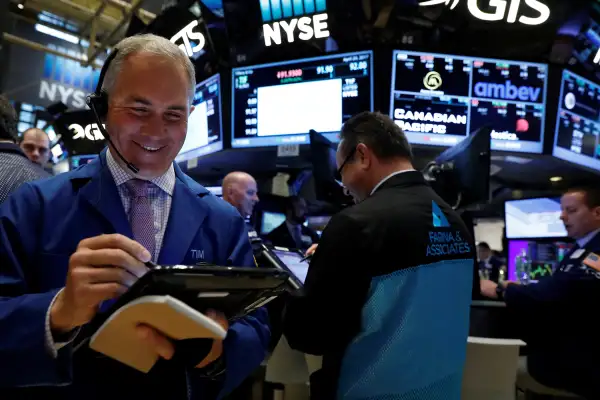Investors Aren't Just Hoping for Trump to Cut Corporate Taxes. They're Banking on It
Money is not a client of any investment adviser featured on this page. The information provided on this page is for educational purposes only and is not intended as investment advice. Money does not offer advisory services.

After soaring more than 200 points on Monday, the Dow Jones industrial average surged another 200 points in early morning trading Tuesday, just a day before the White House is set to unveil the broad strokes of its plan to overhaul taxes, including cutting the top corporate tax rate by more than half.
The Dow is now closing in on the 21,000 mark while the Nasdaq composite index rose above the 6,000 level for the first time in history.
From Wall Street's perspective, the timing couldn't be better. This eight-year-old bull market, now the second oldest in history, has somehow managed to keep charging ahead despite three rather flat years for corporate profits from 2014 through 2016.
Earnings are expected to rebound and grow by around 10% this year, according to FactSet. And the thinking is, a major tax cut could serve as a tailwind that keeps the recovery going by increasing the profitability of some big corporations.
Still, the White House has so hyped a corporate tax cut that it could eventually lose the expectation game.
Investors have grown so enamored with the idea that corporate taxes are headed lower that a survey of money managers by Bank of America Merrill Lynch found that any delay in the passage of those tax cuts is now viewed as the second biggest risk facing the market — bigger even than a possible trade war triggered by President Trump's policies.
The only bigger threat to the bull market, investors say, is the collapse of the Eurozone.
Plus, it remains to be seen what kind and size of tax cut we'll end up with and what the potential impact corporate tax cuts could have on the stock market.
So individual investors need to pay attention to how Washington's machinations can affect their portfolios.
What's the corporate tax rate?
Companies now pay between 15% and 35% percent on their profits, with most tax-paying companies hit with the maximum rate, according to the Tax Policy Center.
But there's a difference between the stated rate and the effective one that companies pay in the real world. A recent U.S. Government Accountability report found that "at least two-thirds of all active corporations had no federal income tax liability" from 2006 to 2012. And less than half of companies with assets in excess of $10 million paid federal incomes taxes in 2012.
The effective federal corporate rate — which is what businesses actually pay after taking credits, deductions, and tax shelters into account — "amounted to about 14% of the pretax net income that they reported in their financial statements...," the GAO report stated. When foreign and state and local taxes are included, the effective corporate rate was 22%.
The Economic Policy Institute, in a separate study, came to a similar conclusion.
What is Trump proposing?
Trump wants to cut the top tax rate from 35% to 15%, according to the Wall Street Journal, even if his plan doesn't offset the loss in revenue by eliminating other tax giveaways.
At 15%, the stated rate would still be slightly above the effective rate that the average profitable company pays in Federal taxes. Moreover, the proposed cut could cost roughly $2 trillion, according to the congressional Joint Committee on Taxation.
The Tax Policy Center looked at Trump's proposed plan during the campaign, and found that his corporate tax reform would cost $2.6 trillion from 2016 through 2026.
What Does Wall Street Think Will Happen?
Lower tax rates, in theory, mean companies can retain more of their profits. When you combine all sectors of the market, companies could see a nearly $11 increase in earnings per share in 2017, or an 8% increase, if Trump can follow through on his pledge, according to a recent note by a Morgan Stanley strategist.
Companies with the highest effective tax rates currently would stand to gain the most. In the S&P 500 index of U.S. stocks, companies that sell basic food and household items — found in the so-called consumer staples sector — had a 30% tax rate over the past 12 months, while real estate and utilities saw only a 4% burden.
The consumer staples sector includes behemoths like Procter & Gamble and Coca-Cola. Consumer discretionary companies like Home Depot and Walt Disney, which sell goods and services that households want, could also be big beneficiaries of Trump's plan.
What Does History Say Will Happen?
Don't count on magic.
While Trump will release more information on Wednesday, chances are his administration won't put forward the actual legislation until the summer.
If his tax plan adds to the deficit, it'll likely be subject to a filibuster in the Senate, which will at the very least delay the process, which could spook the markets.
And despite pronouncements by officials in the White House and Republicans in Congress, there's not a lot of evidence to suggest that lower taxes on business necessarily will stimulate economic growth.
U.S. gross domestic product grew at a much faster rate in the 1950s — when the top corporate tax rate was at or above 50% — than anytime recently.
